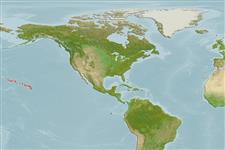>
Ovalentaria/misc (Various families in series Ovalentaria) >
Pomacentridae (Damselfishes) > Glyphisodontinae
Etymology: Abudefduf: Arabic, abu = father; this fish is the leader of the reef against other species (Ref. 45335).
More on authors: Quoy & Gaimard.
Environment: milieu / climate zone / depth range / distribution range
Ökologie
seewasser riff-verbunden; standorttreu; tiefenbereich 1 - 50 m (Ref. 9710). Tropical; 28°N - 15°S, 176°W - 154°W (Ref. 56014)
Eastern Central Pacific: Midway Islands (Ref. 7247) and Hawaii southward to central Polynesia.
Size / Gewicht / Alter
Maturity: Lm ? range ? - ? cm
Max length : 30.0 cm TL Männchen/unbestimmt; (Ref. 9710)
Rückenflossenstacheln (insgesamt) : 13; Rückenflossenweichstrahlen (insgesamt) : 13 - 15; Afterflossenstacheln: 2; Afterflossenweichstrahlen: 13 - 15. Similar to A. bengalensis but has fewer vertical stripes, a black blotch on the posterior base of the dorsal and anal fins, and pointed caudal fin lobes.
Found in quiet waters with rocky bottoms in inshore and offshore reefs; juveniles sometimes found in surge pools (Ref. 205). Benthopelagic (Ref. 58302). Adults form school. Feed on a variety of algae and zooplankton. Oviparous, distinct pairing during breeding (Ref. 205). Eggs are demersal and adhere to the substrate (Ref. 205). Males guard and aerate the eggs (Ref. 205). Used as food by the Hawaiians (Ref. 7364).
Life cycle and mating behavior
Geschlechtsreife | Fortpflanzung | Ablaichen | Eier | Fecundity | Larven
Distinct pairing (Ref. 205). Male guards and aerates eggs (Ref. 205).
Allen, G.R., 1991. Damselfishes of the world. Mergus Publishers, Melle, Germany. 271 p. (Ref. 7247)
IUCN Rote Liste Status (Ref. 130435: Version 2024-1)
Bedrohung für Menschen
Harmless
Nutzung durch Menschen
Fischereien: weniger kommerziell; Aquarium: Kommerziell
Tools
Zusatzinformationen
Download XML
Internet Quellen
Estimates based on models
Preferred temperature (Ref.
123201): 24.2 - 25.5, mean 25.1 °C (based on 54 cells).
Phylogenetic diversity index (Ref.
82804): PD
50 = 0.5000 [Uniqueness, from 0.5 = low to 2.0 = high].
Bayesian length-weight: a=0.02630 (0.01392 - 0.04970), b=3.11 (2.95 - 3.27), in cm total length, based on LWR estimates for this species & Genus-body shape (Ref.
93245).
Trophic level (Ref.
69278): 3.0 ±0.33 se; based on food items.
Widerstandsfähigkeit (Ref.
120179): mittel, Verdopplung der Population dauert 1,4 - 4,4 Jahre. (Preliminary K or Fecundity.).
Fishing Vulnerability (Ref.
59153): Low vulnerability (20 of 100).
Nutrients (Ref.
124155): Calcium = 51.9 [27.3, 83.3] mg/100g; Iron = 0.561 [0.351, 0.878] mg/100g; Protein = 18.4 [17.3, 19.5] %; Omega3 = 0.104 [0.068, 0.158] g/100g; Selenium = 31.9 [18.8, 56.0] μg/100g; VitaminA = 63.3 [18.2, 207.4] μg/100g; Zinc = 1.24 [0.88, 1.74] mg/100g (wet weight);
